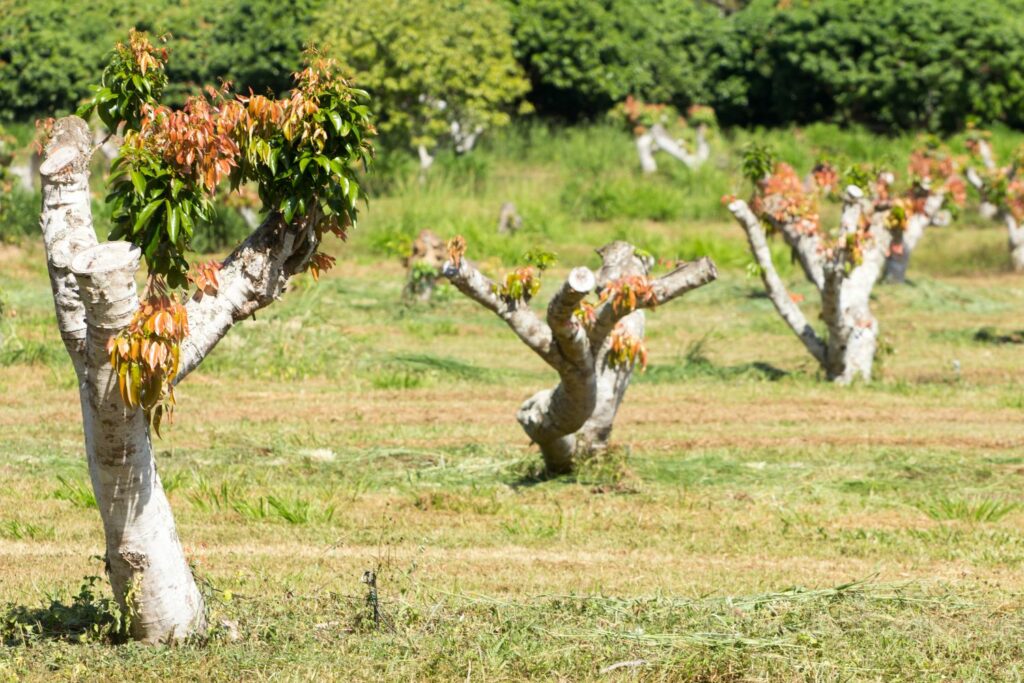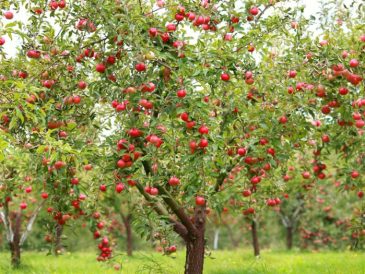Planting the Lychee Tree: How To Plant A Lychee Tree

How to plant a lychee tree – Planting a lychee tree is a rewarding experience, leading to delicious, sweet fruit in a few years. Success depends on careful preparation and consistent care, especially during the crucial initial stages of growth. This guide provides a step-by-step approach to ensure your lychee sapling thrives.
Hole Preparation and Sapling Placement
Proper hole preparation is vital for successful lychee tree establishment. A well-prepared hole allows for optimal root development and prevents initial stress on the young tree. The size and depth of the hole should comfortably accommodate the root ball, allowing for expansion.
- Dig a hole twice as wide and as deep as the lychee sapling’s root ball. This provides ample space for root growth and drainage.
- Gently remove the sapling from its container, taking care not to damage the roots. If the roots are circling, gently loosen them to encourage outward growth.
- Place the sapling in the center of the hole, ensuring the top of the root ball is level with the surrounding ground. Avoid planting it too deep or too shallow.
- Backfill the hole with the excavated soil, ensuring no air pockets remain. Gently firm the soil around the base of the sapling.
Watering and Fertilizing a Newly Planted Lychee Tree
Consistent watering and appropriate fertilization are key to a healthy young lychee tree. Newly planted trees require regular watering to establish a strong root system and prevent wilting. Fertilization provides essential nutrients for growth.
Water deeply and regularly, especially during dry periods. Aim for consistently moist soil, but avoid waterlogging, which can lead to root rot. A slow, deep watering is better than frequent shallow watering. Newly planted trees benefit from a balanced, slow-release fertilizer applied according to package instructions. Avoid over-fertilizing, as this can damage the roots.
Providing Support for Young Lychee Trees
Young lychee trees are susceptible to wind damage, especially in exposed locations. Providing support helps prevent the tree from being uprooted or damaged by strong winds or the weight of the developing fruit.
Stake the young tree using a sturdy stake driven into the ground near the sapling. Use soft materials such as cloth or foam to prevent damage to the trunk. Tie the sapling gently to the stake using soft rope or garden ties, allowing for some flexibility. This support should be maintained until the tree is established and strong enough to withstand wind and fruit weight.
Regularly check the ties to ensure they are not too tight, which could constrict the growth of the trunk.
Troubleshooting Common Lychee Tree Problems

Growing lychees can be a rewarding experience, but like any fruit tree, they’re susceptible to various issues. Understanding these problems and how to address them is crucial for a healthy and productive lychee orchard. Early detection and prompt action are key to minimizing damage and ensuring a bountiful harvest.
Nutrient Deficiencies
Lychee trees, like all plants, require a balanced diet of essential nutrients. Deficiencies can manifest in various ways, impacting growth, fruit production, and overall tree health. Symptoms often appear on the leaves, which are sensitive indicators of nutritional imbalances. For example, a nitrogen deficiency will result in pale green or yellowish leaves, stunted growth, and reduced flowering. Phosphorus deficiency may show up as dark green leaves with purplish tints, while potassium deficiency can lead to leaf scorching and browning, especially at the edges.
Iron deficiency presents as yellowing leaves with green veins (chlorosis), a classic symptom of iron deficiency. Addressing these issues requires soil testing to pinpoint specific deficiencies and applying appropriate fertilizers. Organic options, such as compost and well-rotted manure, can improve soil fertility and provide a slow-release source of nutrients. Chemical fertilizers should be used judiciously and according to the manufacturer’s instructions.
Pest Infestations
Lychee trees are susceptible to a range of pests, including scale insects, mealybugs, aphids, and leaf miners. Scale insects appear as small, immobile bumps on branches and leaves, sucking sap and weakening the tree. Mealybugs are soft-bodied insects covered in white, waxy secretions, often found clustered in leaf axils and on young shoots. Aphids are small, pear-shaped insects that cluster on leaves and stems, also sucking plant sap.
Leaf miners create serpentine tunnels within the leaves, causing unsightly damage. Regular inspection is vital for early detection. Physical removal of pests, such as scrubbing off scale insects, can be effective for small infestations. Natural predators like ladybugs can help control aphid populations. Insecticidal soaps or horticultural oils can be used to manage infestations, but always follow label instructions carefully.
For severe infestations, consulting a local agricultural extension office or arborist is recommended.
Diseases, How to plant a lychee tree
Several fungal and bacterial diseases can affect lychee trees. Anthracnose is a common fungal disease that causes leaf spots, blossom blight, and fruit rot. Symptoms include brown or black lesions on leaves, flowers, and fruit. Phytophthora root rot is a serious disease caused by a soilborne fungus, leading to root damage, wilting, and ultimately tree death. Symptoms include leaf yellowing, wilting, and reduced growth.
Good sanitation practices are crucial for disease prevention. This includes removing and destroying infected plant material, avoiding overhead watering to prevent fungal spore dispersal, and ensuring proper air circulation around the trees. Fungicides can be used to control fungal diseases, but selecting the appropriate fungicide and following application instructions is essential. For serious diseases, professional advice should be sought.
Successful lychee cultivation begins with selecting a suitable sapling and preparing well-drained soil. Understanding the optimal planting techniques is crucial, particularly given the distinction between a tree, with its characteristic woody trunk and long lifespan, and a plant, which encompasses a broader range of growth habits as described in this article on the difference between a tree and a plant.
Properly planting a lychee tree, therefore, involves considerations beyond simple seed germination; factors like sunlight exposure and soil nutrient levels must also be carefully managed.
Illustrative Examples of Healthy and Unhealthy Lychee Trees

Spotting a thriving lychee tree from a struggling one is key to successful cultivation. A healthy tree will reward you with bountiful harvests, while an unhealthy one might yield little or nothing, and could even die. Understanding the visual cues is crucial for early intervention and preventing problems.Knowing the difference between a healthy and unhealthy lychee tree comes down to observing several key characteristics.
These include the overall growth habit, leaf color and texture, the presence or absence of fruit, and any signs of disease or pest damage. By carefully examining these aspects, you can quickly assess the health of your lychee tree and take appropriate action.
Healthy Lychee Tree Characteristics
A healthy lychee tree displays vibrant growth and abundant fruit production. Its leaves are a deep, glossy green, exhibiting a smooth texture and firm structure. The branches are strong and evenly spaced, indicating vigorous growth. The tree’s overall shape is well-balanced and symmetrical, without any noticeable signs of wilting or dieback. A healthy mature tree will bear numerous clusters of fruit, typically round and firm, with a smooth, reddish-brown skin when ripe.
The leaves are generally free from blemishes, pests, or discoloration. A healthy tree shows strong, upward growth, suggesting good root health and nutrient uptake. The bark is smooth and light brown, with minimal cracking or discoloration.
Unhealthy Lychee Tree Characteristics
In contrast, an unhealthy lychee tree shows a range of distress signals. The leaves might appear yellowed, pale, or even brown and withered, indicating nutrient deficiencies, diseases, or pest infestations. The branches might be sparse, weak, or exhibiting dieback, suggesting stress or root problems. Fruit production, if any, is likely to be sparse, with fruits that are smaller than usual, misshapen, or showing signs of damage.
The overall growth habit is stunted and unbalanced, often with a lopsided or uneven canopy. The bark may show signs of cracking, lesions, or discoloration. In severe cases, significant leaf drop or branch death is observed. The presence of visible pests (such as scale insects or mealybugs) or signs of disease (such as leaf spots or cankers) are clear indicators of an unhealthy tree.
Comparison of Healthy and Unhealthy Lychee Trees
The differences between a healthy and unhealthy lychee tree are quite stark. A healthy tree exhibits vigorous growth, abundant fruit production, and healthy foliage. The leaves are a rich green, the branches are strong and evenly spaced, and the overall shape is well-balanced. An unhealthy tree, on the other hand, shows signs of stress, including stunted growth, sparse or damaged foliage, reduced fruit production, and the possible presence of pests or diseases.
The leaves may be yellowed, brown, or otherwise discolored, and the branches may be weak or dead. Comparing the two side-by-side highlights the importance of regular observation and prompt action to address any signs of distress in your lychee tree. A healthy tree is a testament to proper care and maintenance, while an unhealthy one serves as a warning sign that intervention is needed.
Questions Often Asked
Can I grow a lychee tree in a pot?
While lychee trees prefer in-ground planting for optimal growth, you can grow them in large containers, provided you ensure proper drainage and sufficient sunlight. Be prepared to repot as the tree grows.
How long does it take for a lychee tree to bear fruit?
It typically takes 3-5 years for a lychee tree to start producing fruit, depending on the cultivar and growing conditions. Some varieties may take longer.
What are the signs of an unhealthy lychee tree?
Signs include yellowing or browning leaves, wilting branches, stunted growth, presence of pests or diseases, and lack of fruit production.
How do I protect my lychee tree from frost?
Lychee trees are sensitive to frost. During cold spells, protect young trees with frost cloth or move potted trees indoors. Established trees may need some protection around their base.


